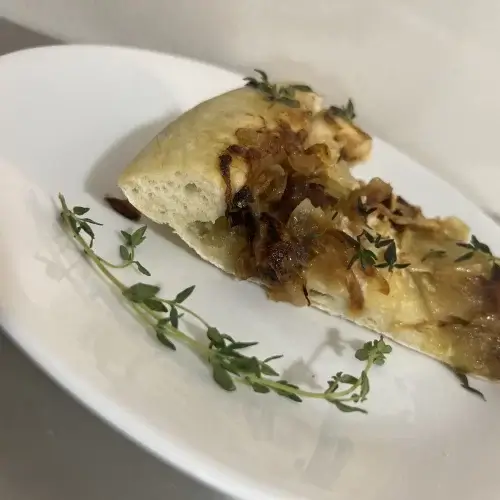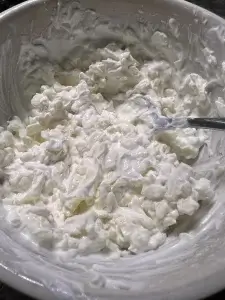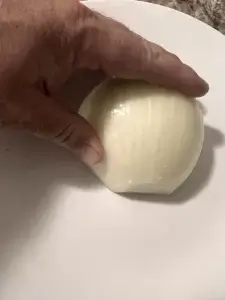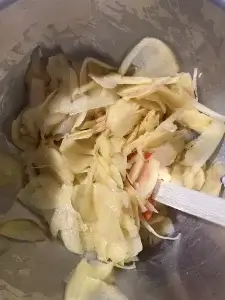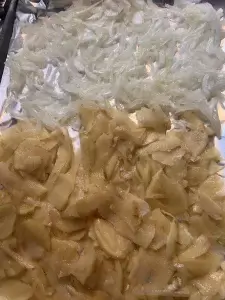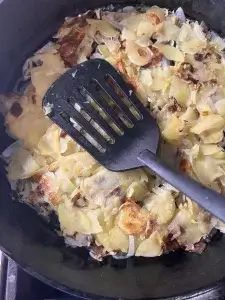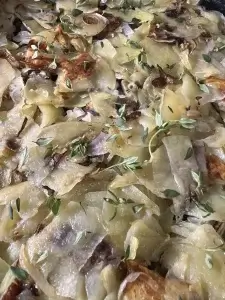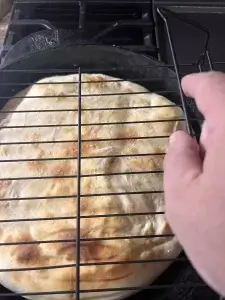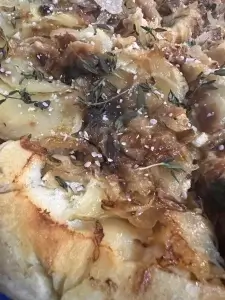Topsy-Turvy Upside Down Cast Iron Al Contrario Pizza Pie
Bucket of Bread
Flip Your Pizza Night on Its Head with This Cast Iron Masterpiece! The combination of Gruyère, sour cream, onions, potatoes, and thyme in this unique pizza recipe brings a rich and savory flavor that elevates the dish to gourmet status. The creamy Gruyère pairs perfectly with the tangy sour cream, while the onions and potatoes add a comforting, hearty texture. A hint of thyme ties everything together, offering a fragrant, earthy note that complements the entire ensemble. This isn't just another pizza; it's a delightful twist on tradition that will surprise and satisfy your taste buds. Thank you for the inspiration, Chris Kimball!
Course Appetizer, Breakfast, Dinner, lunch, Main Course, Side Dish, Snack, Supper
Cuisine American, Italian
- 1 Bucket Your favorite Bucket of Bread Brand Dough Traditional White is shown and is recommended to prepare it as below and not as per the back of the bucket
- 1 Cup Large Onion Thinly Sliced
- 1 Cup Yukon Gold Potato Thinly Sliced
- 1 Bundle Fresh Thyme You may also use other fresh herbs like rosemary, oregano, or basil.
- 1 Cup Gruyère Shredded
- 1 Cup Sour Cream Your amount may vary
- 1 Sprinkle Salt Course
- 1 Sprinkle Pepper To Taste
- 2 Drizzles Olive Oil
Make the Dough
Before mixing your dough, set a spoonful of the flour to the side.
Pull back on the water just a little bit and not more than 1/4 of a cup.
Start the Toppings
Start the oven to 500 °F
Shred some Gruyère cheese. Mix in some sour creme so it looks similar in consistency to this picture.
Add some fresh ground pepper for flavor.
Thinly slice some Golden Yukon potatoes.
Thinly slice a yellow onion.
Drizzle in a light coat of olive oil into a bowl and mix in the potatoes.
Drizzle in a light coat of olive oil into a bowl and mix in the onions.
Place both the onions and potatoes onto a non-stick lined cooking sheet and bake them for approximately 15 mins at 500 °F.
Bake the Toppings
In a seasoned and lightly oiled cast iron skillet place the onions in a thin layer.
Next, add the potatoes.
Then, finally, some fresh thyme. The oven should already be at 500 °F, so now bake the cast iron for about 15 mins.
Add the Pizza Dough
Prepare the dough on the counter using the flour previously set aside to prevent sticking.
Add the cheese mixture to the skillet in a thin layer.
Form the dough around the ingredients.
Bake at for about 15 minutes at 500 °F for until the desired color is reached.
Flip It!
Be Careful! This is REALLY-REALLY hot! Place a cooling rack or a larger than the cast iron skillet sized plate on top of the pizza.
Did I mention it is really HOT? Be careful, I used a kitchen towel just to try not to burn my hand.
CAREFULLY flip it over and get ready to serve up something delicioso and I didn't burn my hand!
Fun Fact: Upside-Down Culinary Creations from Around the World
The technique of cooking dishes "upside down" is a culinary method that spans across various cultures, each adding its own unique twist to the concept. These dishes often feature ingredients that are layered in a specific order, cooked, and then inverted before serving, revealing a beautifully crafted, flavor-packed meal.
Maqluba (Middle East)
One of the most iconic upside-down dishes is "Maqluba," a Middle Eastern comfort food that’s been cherished for generations. Traditionally, this dish consists of layers of rice, meat (such as chicken or lamb), and vegetables like eggplant, cauliflower, and tomatoes. After cooking, the pot is carefully flipped upside down onto a serving platter, revealing a stunning, multi-layered creation. The slow cooking allows the ingredients to meld together, creating a deeply flavorful and aromatic dish.
Tarte Tatin (France)
In France, the "Tarte Tatin" is a classic example of upside-down baking in the world of desserts. This beloved apple tart was famously created by accident when the Tatin sisters of Lamotte-Beuvron inadvertently baked apples and caramel on the bottom of a pan and decided to cover it with pastry. When the tart was flipped over, the result was a beautiful, golden-crusted dessert with soft, caramelized apples on top. It has since become a staple in French patisseries, celebrated for its rich, buttery flavor and delightful presentation.
Pineapple Upside-Down Cake (United States)
The Pineapple Upside-Down Cake is an American classic that showcases the beauty of upside-down baking in a sweet, nostalgic way. This dessert became popular in the early 20th century, especially in the 1950s, when canned pineapple rings were widely available. The cake is made by placing pineapple slices and maraschino cherries in the bottom of a cake pan, covering them with a brown sugar and butter mixture, and then pouring cake batter over the top. Once baked, the cake is inverted to reveal a gorgeous, fruity topping that’s caramelized to perfection.
Biryani (India)
In Indian cuisine, the "Dum Biryani" is a fragrant, spiced rice dish that is sometimes cooked using an upside-down method. Ingredients like marinated meat (chicken, lamb, or goat), basmati rice, and a blend of aromatic spices are layered in a pot, which is then sealed with dough to trap the steam. Traditionally, the pot is then inverted to serve, allowing the flavors to blend beautifully while ensuring that the meat and rice remain tender and moist. The result is a vibrant, flavor-packed dish that’s a feast for both the eyes and the palate.
Kuchen (Germany)
In Germany, there’s a dessert known as "Versunkener Apfelkuchen" or "Sunken Apple Cake," which is an upside-down cake where apples are arranged at the bottom of a cake pan and covered with batter. After baking, the cake is turned upside down to reveal the soft, juicy apples that have sunk into the cake. This dessert is particularly popular in the fall and showcases the simple, comforting flavors of apples combined with the richness of a buttery cake.
Bánh Tét (Vietnam)
In Vietnamese cuisine, "Bánh Tét" is a traditional savory sticky rice cake that’s often made for Lunar New Year. The cake is filled with mung beans, pork, and sometimes other ingredients, wrapped in banana leaves, and then steamed. While not exactly flipped, the cooking method ensures that the rice on the outside becomes slightly caramelized, while the filling inside remains soft and flavorful. The cake is sliced into rounds, revealing a beautiful cross-section of the layers.
These global examples highlight the versatility and creativity that upside-down cooking can bring to the kitchen. Whether you’re making a savory main course or a sweet dessert, the technique of inverting your dish after cooking adds a layer of surprise and delight, enhancing both the presentation and the flavors. As you prepare your Al Contrario Pizza, you’re joining a long line of culinary innovators who have discovered the magic of upside-down cooking!Keyword Gruyère, pizza, Pizza Dough, thyme
